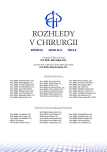Cost-effectiveness of negative pressure wound therapy in outpatient setting
Authors:
J. Stryja 1; R. Staffa 2; D. Říha 3; K. Stryjová 3; K. Nicielniková 3
Authors place of work:
Vzdělávací a výzkumný institut AGEL, o. p. s., ředitelka: Mgr. N. Peloušková, Ph. D.
1; II. chirurgická klinika, Centrum cévních onemocnění, FN u sv. Anny v Brně a LF MU, Brno, přednosta: prof. MUDr. R. Staffa, Ph. D.
2; Nemocnice Podlesí, a. s., Třinec, primář: MUDr. D. Říha
3
Published in the journal:
Rozhl. Chir., 2015, roč. 94, č. 8, s. 322-328.
Category:
Původní práce
Summary
Introduction:
The negative pressure wound therapy (NPWT) is an effective local treatment method of many non-healing wounds. NPWT is routinely used for inpatient treatment in the Czech Republic; however, no clinical data is available for systematic outpatient treatment.
Methods:
The prospective non-randomized study was used to compare the clinical impact and cost-effectiveness of diabetic leg-ulcer and foot-ulcer negative pressure treatment in outpatient and inpatient settings. The aim of the study was to assess the effectiveness of outpatient NPWT on the basis of wound bed evaluation, to detect and quantify pre-expected reductions in the total costs of the therapy, and to compare the efficacy of both treatment options. Enrolled subjects included inpatients (n=36, NPWT systems RENASYS GO or PICO) and outpatients (n=28, PICO system). NPWT was concluded when the wound bed had been totally covered by granulation tissue, or when serious health problems occurred. We monitored the ulcer area, wound bed trait, number of NPWT dressing changes, length of NPWT, intensity of pain (VAS scale), presence of complications, and treatment costs.
Results:
We found comparable clinical efficacy of outpatient (n=28)/inpatient (n=36; statistically non-significant differences in healing of ulcers verified based on wound bed development and reduction of ulcer areas in time) NPWT, the same risk of complications associated with NPWT (statistically non-significant differences in the function of both technologies and in complications developed during follow-up) as well as similar long-term results (statistically non-significant differences in the count of amputations). The total costs for outpatient wound treatment were statistically significantly lower (EUR 600 versus EUR 1300, p=0.001), and so were the average one-day-NPWT costs (EUR 30 versus EUR 120, p=0.001).
Conclusion:
We demonstrated that outpatient diabetic-foot-ulcer NPWT provided the same clinical efficiency as inpatient NPWT, while outpatient NPWT was less expensive, less painful and better tolerated than inpatient NPWT.
Key words:
negative pressure wound therapy − diabetic foot syndrome
Zdroje
1. Nain PS, Uppal SK, Garg R, et al. Role of negative pressure wound therapy in healing of diabetic foot ulcers. J Surg Tech Case Rep 2011;3:17−22.
2. Sepúlveda G, Espíndola M, Maureira M, et al. Negative-pressure wound therapy versus standard wound dressing in the treatment of diabetic foot amputation. A randomised controlled trial. Cirugía Espanola 2009;86:171−7.
3. Armstrong DG, Lavery LA. Negative pressure wound therapy after partial diabetic foot amputation: a multicentre, randomized controlled trial. Lancet 2005;366:1704−10.
4. Novak A, Wasim S Khan, Palmer J, et al. The evidence-based principles of negative pressure wound therapy in trauma & orthopedics. Open Orthop J 2014;8:168–177.
5. Bakker et al. Practical guidelines on the management and prevention of the diabetic foot 2011. Diabetes Metab Res Rev 2012; 28(Supl 1):225−31.
6. Fife CE, Walker D, Thomson B, et al. The safety of negative pressure wound therapy using vacuum-assisted closure in diabetic foot ulcers treated in the outpatient setting. Int Wound J 2008;5 (Suppl. 2):17−22.
7. Wu SC, Armstrong DG. Clinical outcome of diabetic foot ulcers treated with negative pressure wound therapy and the transition from acute care to home care. Int Wound J 2008; 5 (Suppl. 2):10−6.
8. Woo KY, Sibbald RG. Vacuum-assisted closure home care training: a process to link education to improved patient outcomes. Int Wound J 2008;5 (Suppl. 2):1−9.
9. Stryja J. Systémy kontrolovaného podtlaku a jejich využití v praxi. In: Šimek M, Bém R, et al. Podtlaková léčba ran. 1. vyd. Praha, Maxdorf; 2013:29−44,15.
10. Apleqvist J, Armstrong DG, Lavery LA, et al. Resource utilization and economic costs of care based on a randomized trial of vacuum-assisted closure therapy in the treatment of diabetic foot wounds. Am J Surg 2008;195:782−8. Epub 2008 Mar 26.
Štítky
Chirurgie všeobecná Ortopedie Urgentní medicínaČlánek vyšel v časopise
Rozhledy v chirurgii

2015 Číslo 8
- Metamizol jako analgetikum první volby: kdy, pro koho, jak a proč?
- Specifika v komunikaci s pacienty s ránou – laická doporučení
- Léčba akutní pooperační bolesti z pohledu ortopeda
Nejčtenější v tomto čísle
- Vývoj konstrukcí střevních anastomóz a současný stav jejich možností
- Von Meyenburgovy komplexy – mnohočetné biliární hamartomy imitující metastatický jaterní proces
- Kolorektální karcinom z prstenčitých buněk – kazuistika
- Farmakoekonomika ambulantní terapie ran kontrolovaným podtlakem
